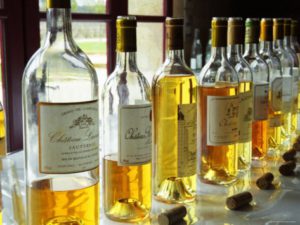 Interesting…. I have read two articles in the last few days that have slightly opposing views about residual sugar in wine. A few days ago this heading appeared on the Snooth website:
Interesting…. I have read two articles in the last few days that have slightly opposing views about residual sugar in wine. A few days ago this heading appeared on the Snooth website:
Sweet Bordeaux is the new black
“Older generations of wine drinkers are taking cues from a younger generation that see the possibilities of Sweet Bordeaux white wines to create new and unique dining experiences. Sweet Bordeaux wines can be enjoyed in a multitude of Instagram-worthy moments throughout a meal. And they are available at an accessible range of prices, from value to premium and everything in between.
Sweet Bordeaux is operating around the world to promote the consumption of fruity and aromatic Bordeaux white wines through master classes, trade tastings, and trade shows. They also organize press trips that expose wine professionals to the possibilities of Sweet Bordeaux, especially when it comes to food and wine pairing”. Snooth – October 29, 2017
This article appears to suggest that the move toward sweet or sweeter wine is something of a new trend, whereas the history of wine drinking, especially when it comes to residual sugar, appears to reveal a slightly different viewpoint. Written by my learned friend Tim Hanni MW.
“We are all genetically pre-programmed with attractions and aversions. Changes in preferences, from about four years old to very late in life, are largely reorganising what certain sensations represent. So, with observation, culture, peer pressure, and learning we adapt to associate things we didn’t like with aspiration or attainment – something we often refer to as an ‘acquired’ taste. We also equally associate things in a negative light, ‘disposing’ of tastes as well, such as the current hysteria over sweetness in wine for those who have become more ‘sophisticated’. Disposing of sweetness is easy for some people and impossible for a huge segment of the global market, and our insistence on dry wine as ‘good’ wine is ridiculous and does not serve the wine industry or reflect the history and traditions of wine.
Dry wines are the new fad (in relative terms) not the historical standard; the 1947 Château Cheval Blanc had over 30 g/L (3%) residual sugar. Most prized white Rhône wines were vins de paille – dried on mats and made into sweet wines. Countless sweet wines, including Château d’Yquem, were thought completely appropriate with fish, beef, or oysters. Montrachet, in the greatest vintages, was very sweet, not dry. Champagnes, as consumed in France, often had 140 g/L (14%) residual sugar – a lot more than American Coca Cola which has 108 g/L (10.1%) residual sugar. The global sweet wine opportunity was, and still is, about 25% to 40% of the total available market. Things have just gotten out of control with the dry wine fashionistas. And keep in mind that as wine has gone dry, consumption in France and Italy has plummeted.” Meininger’s Wine Business International – October 2017
I must confess that the stats relating to amount of residual sugar in some of these old wines took me somewhat by surprise.
 Interesting…. I have read two articles in the last few days that have slightly opposing views about residual sugar in wine. A few days ago this heading appeared on the Snooth website:
Interesting…. I have read two articles in the last few days that have slightly opposing views about residual sugar in wine. A few days ago this heading appeared on the Snooth website: 

